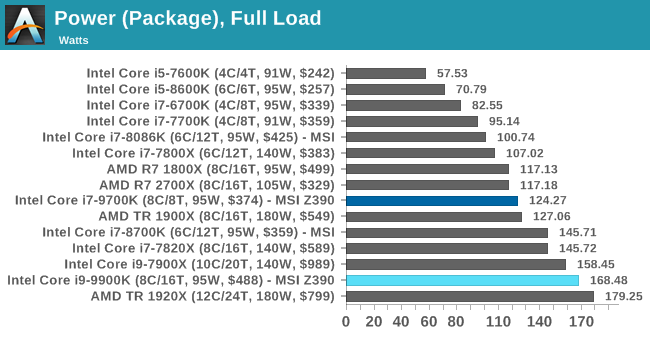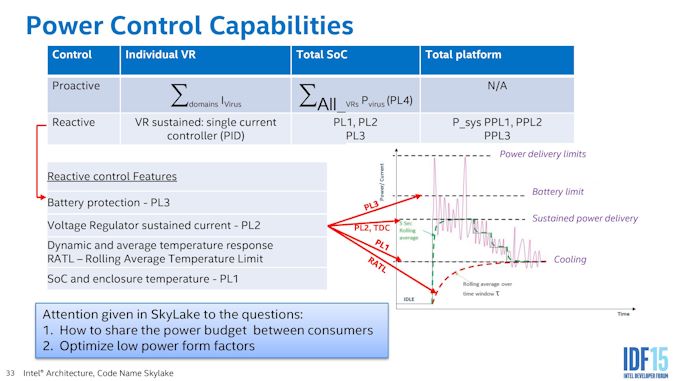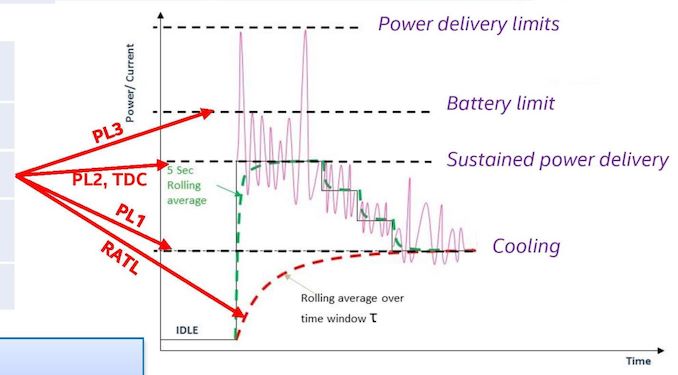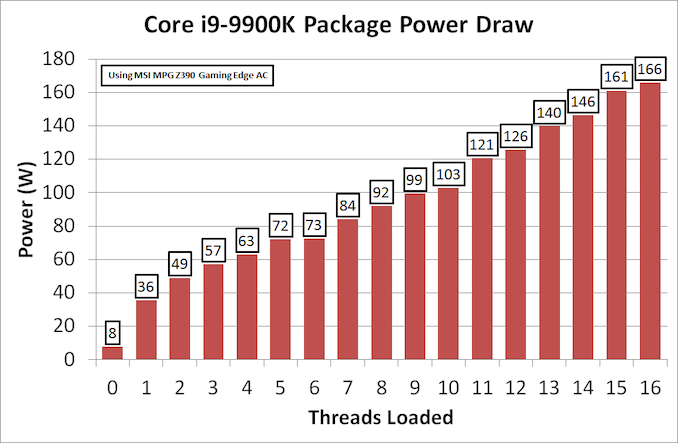The Intel 9th Gen Review: Core i9-9900K, Core i7-9700K and Core i5-9600K Tested
by Ian Cutress on October 19, 2018 9:00 AM EST- Posted in
- CPUs
- Intel
- Coffee Lake
- 14++
- Core 9th Gen
- Core-S
- i9-9900K
- i7-9700K
- i5-9600K
Power Consumption
TDP or not the TDP, That is The Question
Notice: When we initially posted this page, we ran numbers with an ASRock Z370 board. We have since discovered that the voltage applied by the board was super high, beyond normal expectations. We have since re-run the numbers using the MSI MPG Z390 Gaming Edge AC motherboard, which does not have this issue.
As shown above, Intel has given each of these processors a Thermal Design Power of 95 Watts. This magic value, as mainstream processors have grown in the last two years, has been at the center of a number of irate users.
By Intel’s own definitions, the TDP is an indicator of the cooling performance required for a processor to maintain its base frequency. In this case, if a user can only cool 95W, they can expect to realistically get only 3.6 GHz on a shiny new Core i9-9900K. That magic TDP value does not take into account any turbo values, even if the all-core turbo (such as 4.7 GHz in this case) is way above that 95W rating.
In order to make sense of this, Intel uses a series of variables called Power Levels: PL1, PL2, and PL3.
That slide is a bit dense, so we should focus on the graph on the right. This is a graph of power against time.
Here we have four horizontal lines from bottom to top: cooling limit (PL1), sustained power delivery (PL2), battery limit (PL3), and power delivery limit.
The bottom line, the cooling limit, is effectively the TDP value. Here the power (and frequency) is limited by the cooling at hand. It is the lowest sustainable frequency for the cooling, so for the most part TDP = PL1. This is our ‘95W’ value.
The PL2 value, or sustained power delivery, is what amounts to the turbo. This is the maximum sustainable power that the processor can take until we start to hit thermal issues. When a chip goes into a turbo mode, sometimes briefly, this is the part that is relied upon. The value of PL2 can be set by the system manufacturer, however Intel has its own recommended PL2 values.
In this case, for the new 9th Generation Core processors, Intel has set the PL2 value to 210W. This is essentially the power required to hit the peak turbo on all cores, such as 4.7 GHz on the eight-core Core i9-9900K. So users can completely forget the 95W TDP when it comes to cooling. If a user wants those peak frequencies, it’s time to invest in something capable and serious.
Luckily, we can confirm all this in our power testing.
For our testing, we use POV-Ray as our load generator then take the register values for CPU power. This software method, for most platforms, includes the power split between the cores, the DRAM, and the package power. Most users cite this method as not being fully accurate, however compared to system testing it provides a good number without losses, and it forms the basis of the power values used inside the processor for its various functions.
Starting with the easy one, maximum CPU power draw.

Focusing on the new Intel CPUs we have tested, both of them go beyond the TDP value, but do not hit PL2. At this level, the CPU is running all cores and threads at the all-core turbo frequency. Both 168.48W for the i9-9900K and 124.27W for the i7=9700K is far and above that ‘TDP’ rating noted above.
Should users be interested, in our testing at 4C/4T and 3.0 GHz, the Core i9-9900K only hit 23W power. Doubling the cores and adding another 50%+ to the frequency causes an almost 7x increase in power consumption. When Intel starts pushing those frequencies, it needs a lot of juice.
If we break out the 9900K into how much power is consumed as we load up the threads, the results look very linear.
This is as we load two threads onto one core at a time. The processor slowly adds power to the cores when threads are assigned.
Comparing to the other two ‘95W’ processors, we can see that the Core i9-9900K pushes more power as more cores are loaded. Despite Intel officially giving all three the same TDP at 95W, and the same PL2 at 210W, there are clear differences due to the fixed turbo tables embedded in each BIOS.
So is TDP Pointless? Yes, But There is a Solution
If you believe that TDP is the peak power draw of the processor under default scenarios, then yes, TDP is pointless, and technically it has been for generations. However under the miasma of a decade of quad core processors, most parts didn’t even reach the TDP rating even under full load – it wasn’t until we started getting higher core count parts, at the same or higher frequency, where it started becoming an issue.
But fear not, there is a solution. Or at least I want to offer one to both Intel and AMD, to see if they will take me up on the offer. The solution here is to offer two TDP ratings: a TDP and a TDP-Peak. In Intel lingo, this is PL1 and PL2, but basically the TDP-Peak takes into account the ‘all-core’ turbo. It doesn’t have to be covered under warranty (because as of right now, turbo is not), but it should be an indication for the nature of the cooling that a user needs to purchase if they want the best performance. Otherwise it’s a case of fumbling in the dark.














274 Comments
View All Comments
muziqaz - Monday, October 22, 2018 - link
I love the price of $488 stamped all over each of the test results, while over here in UK I see price of £599 and newegg quotes $580. Even your linked amazon has it at $580. And conclusion is awesome with: "At $488 SEP, plus a bit more for 'on-shelf price'..." Since when is extra 100 bucks a bit more? :Dcompudaze - Monday, October 22, 2018 - link
What was the actual vcore for your overclocks?HardwareDufus - Monday, October 22, 2018 - link
I7-9700k.... an I7 that isn't hyperthreaded.... let's totally muddy the waters now Intel.... Guess they had to save some feature for the I9's $100+ surcharge...… Good grief.bogda - Tuesday, October 23, 2018 - link
How pointless is reviewers comment: "... World of Tanks gives the 9900K some room to stretch its legs..."?Difference between two chips in discussion is between 712fps and 681fps! Not even Neo from Matrix could note the difference.
How pointless is discussing top of the line CPU gaming performance in 720p in any game??
How pointless is marketing 8C/16T CPU for gamers???
sseyler - Tuesday, October 23, 2018 - link
Not sure whether this has been pointed out yet, but the Threadripper prices need to be updated. For example, the 1920X is now well under $500 as advertised even on AMD's website and the 1900X goes for $350 on Newegg.dlum - Tuesday, October 23, 2018 - link
For me, listing the long-obsolete prices for AMD processors (still initial, long-outdated MSRP for 1920x $799 - whereas a simple amazon search confirms it's now for just over half of that ($431)) is clearly disrespectful and shamefull practice for a reviewer.It's very sad such dishonest practices found their way to Anandtech and they are so prominent here.
Probably that's also why no one answers nor fixes those clearly misleading figures.
(Maybe that's the cost of being able to read such anyway valuable reviews for free :)
sseyler - Thursday, October 25, 2018 - link
Well, to be fair, I'm sure the editors didn't dig this deeply through the comments. They're busy people.Also, I think I heard something mentioned before about their graphs having some semi-automatic mechanism for listing prices and the like. I don't remember exactly, but it probably has something to do with pulling MSRP data and it's difficult to change given the way the templated graphs are generated from the benchmarks.
I imagine it was done something like this for consistency across the site as well as not biasing prices according to specific vendors. Given the first reason, I don't know why it'd be difficult for individual editors to customize/tweak certain aspects, but maybe that needs to be revised to be more flexible. As for the second reason, there are clearly reasonable solutions, like finding the *current* MSRP (rather than the release MSRP), or selecting the lowest/median/average price among a pool of selected retailers.
Anyway, it doesn't make much sense to me to characterize this as an instance of dishonesty, but rather a technical detail that's important enough to invest the time in it's improvement.
sseyler - Thursday, October 25, 2018 - link
its*zodiacfml - Wednesday, October 24, 2018 - link
Meh. Intel owner could simply delidd and approach these kinds of performance.Resolution above 1080p, AMDs parts have better value.
zodiacfml - Wednesday, October 24, 2018 - link
Made the comment without reading the review. The difference is a lot smaller than I expected where the only useful difference is in Ashes where AMD usually dominates due to sheer core count.I'd be fine with that 6 core CPU from AMD.